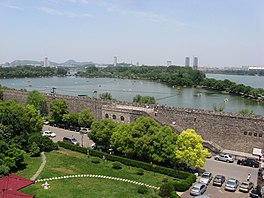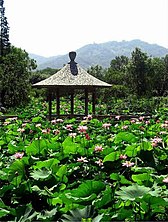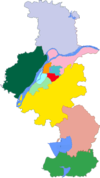Xuanwu Lake
| Xuanwu Lake | |
|---|---|
 Xuanwu Lake, with the Nanjing City Wall in the foreground, its islands in the center of the lake, and Nanjing's skyline and mountains in the distance. This is seen from Taicheng, the part of the City Wall that lines the west side of the lake. | |
| Location | Xuanwu District, Nanjing, Jiangsu |
| Coordinates | 32°04′23″N 118°47′54″E / 32.07306°N 118.79833°E |
| Basin countries | China |
| Surface area | 444 hectares (1,100 acres) |
| Islands | 5 |
Xuanwu Lake (Chinese:
History
[edit]The lake was formed, according to geologists, when tectonic plates shifted and created Mount Yanshan. A legend is that Emperor Sun Quan (182–252) settled in the Nanjing area and he had the lake created and filled with water.[1] The lake was named for a black dragon, believed to be a water god by Chinese Taoists, from a Southern dynasty (420-859) legend. The dragon, seen in the lake, looked like a tortoise and a snake and was named Xuanwu, meaning black tortoise.[1]
During the Six Dynasties period (222–859) a garden on a basaltic site was created, which is now considered one of the most scenic places in the park.[2] The area was used for hunting and training by the emperor's family members.[3]
Also called "Military Rehearsal Lake", the lake was used for naval battle exercises during the Song dynasty (960–1279).[1][4] The "Yellow Book Storage", or the "Yellow Register Archives", was built there in the beginning of the Ming dynasty (1368-1644), and it was thus made an imperial garden and "forbidden land".[3][5]
The lake and surrounding area was made into a park in 1911 after the end of the Qing dynasty.[1][4] It was renamed from Yuanwu Lake Park to "Continental Park" in 1928 and officially made Xuanwu Lake Park in 1935.[3] A plan was made for the 2005 creation of the Li Yu Cultural Park, Garden Park, Qingyinge pavilion and an immortality garden.[3]
Description
[edit]The main entrance to the Xuanwu Lake Park is through Xuanwu Gate, which is part of the Nanjing City Wall that borders the south and east portions of the park and Ji Ming Temple is in its southwestern area.[1] The Zifeng Tower overlooks the lake.[citation needed] The 444 hectares (1,100 acres) lake is 15 kilometres (9.3 mi) in circumference.[1] Xuanwu Lake has a surface area of 3.78 square kilometres (1.46 sq mi). In recent years, the amount of water diverted from the upper reaches of Xuanwu Lake has increased, and the water quality has improved, supporting many creatures.[6]
-
Xuanwu Lake with Purple Mountain in the distance
-
Xuanwu Lake, with the city skyline and Nanjing's City Wall in the distance
-
Pool and Nanjing City Wall
Park
[edit]Xuanwu Lake Park (
Within the scenic park are pagodas, pavilions, tea houses, and restaurants. Entertainment options include boating, zoo, and an outdoor theatre.[4] Key attractions include the Nuo'na tower, Lama Temple, cenotaph of Guo Pu, and the Rose Garden. On the lake are boats and ferries. It is also considered the "Pearl of the Stone City".[3] If desired, a visitor could stroll through the park for up to five hours.[7]
-
Willows
-
Lotus flowers
-
Lake view
-
Lansheng Tower
It is designated a National Grade AAAA Attraction.[8] The City of Nanjing has identified it as one of the top five parks in the city. Others are Mochou Lake Park, Qingliangshan Park, Wuchaomen Park and China Gate Castle Park.[7]
Nanjing's Couple Park, or Qinglüyuan Xuanwu (
References
[edit]- ^ a b c d e f g Xuanwu Lake. China Internet Information Center. Retrieved May 14, 2014.
- ^ The North Lake. Published in Nanjing Times and posted on China Dictionary (www.88dict.com). Retrieved May 15, 2014.
- ^ a b c d e f Humanities: Collection of Scenic Spots & Historic Sites: Xuanwu Lake Park. Archived May 17, 2014, at the Wayback Machine City of Nanjing. Retrieved May 15, 2014.
- ^ a b c DK Eyewitness Travel Guide: China. DK Publishing; 1 June 2012. ISBN 978-0-7566-9328-2. p. 226.
- ^ Wenxian Zhang, The Yellow Register Archives of Imperial Ming China. Project MUSE. Retrieved May 15, 2014.
- ^ Pang, Min; Song, Weiwei; Liu, Yuan; Pang, Yong (2021-05-27). "Simulation of the Parameters Effecting the Water Quality Evolution of Xuanwu Lake, China". International Journal of Environmental Research and Public Health. 18 (11): 5757. doi:10.3390/ijerph18115757. ISSN 1660-4601. PMC 8198726. PMID 34071994.
- ^ a b c d Nanjing's Best Parks: Xuanwu Lake Park. City of Nanjing. Retrieved May 13, 2015.
- ^ Xuanwu Lake. Jiangsu.NET. Retrieved May 14, 2014.
- ^ Qinglvyuan Xuanwu, Nanjing, China. Google maps. Retrieved May 13, 2014.
External links
[edit]- Official site (Chinese)
- Xuanwu Lake Park map (Chinese)










